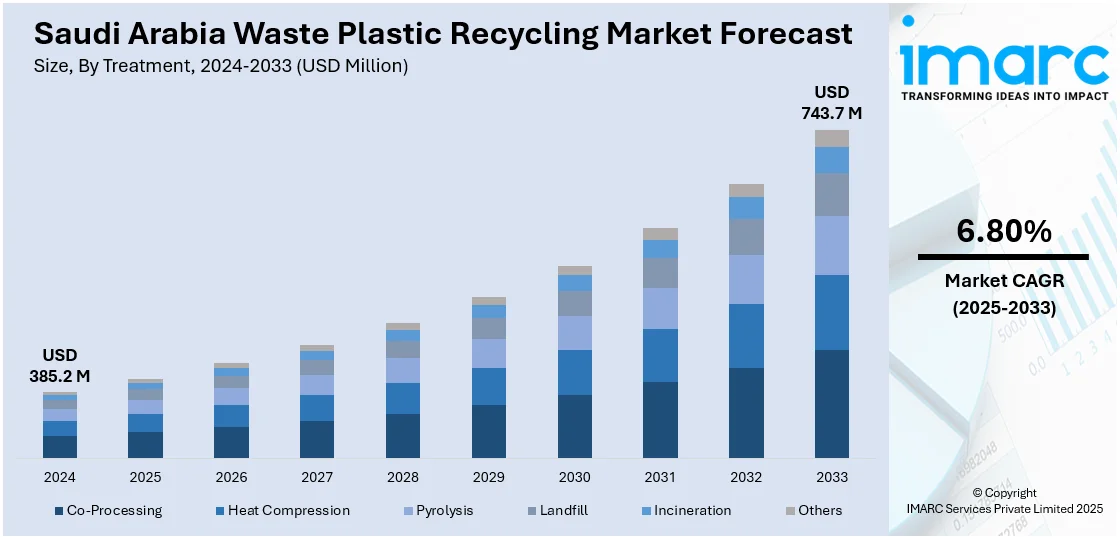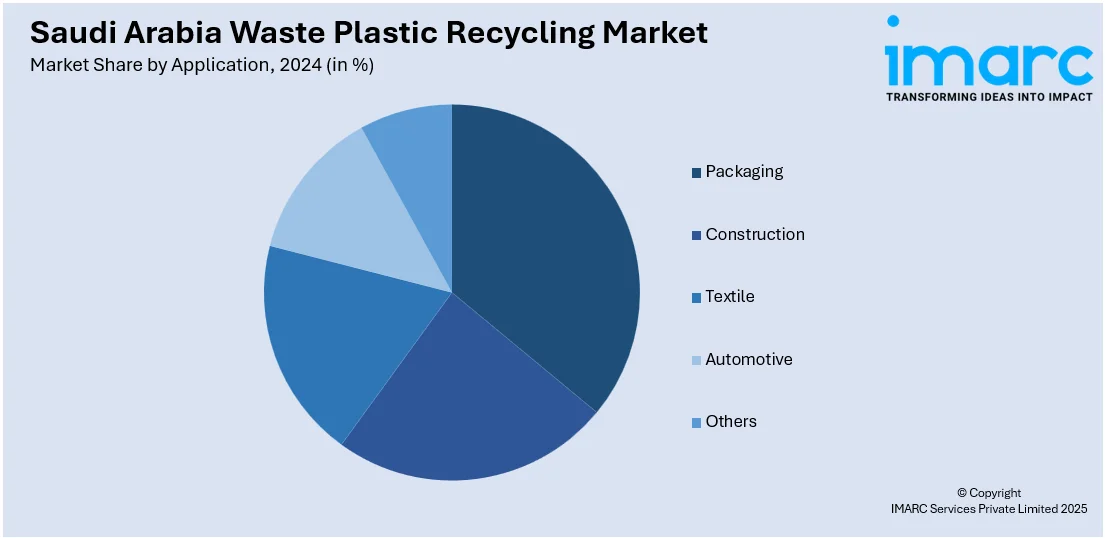
Saudi Arabia Waste Plastic Recycling Market Size, Share, Trends and Forecast by Treatment, Material, Application, Recycling Process, and Region, 2025-2033
Saudi Arabia Waste Plastic Recycling Market Overview:
The Saudi Arabia waste plastic recycling market size reached USD 385.2 Million in 2024. Looking forward, IMARC Group expects the market to reach USD 743.7 Million by 2033, exhibiting a growth rate (CAGR) of 6.80% during 2025-2033. The market is driven by regulatory pressure to reduce landfill usage, increasing industrial demand for recycled polymers, rising environmental awareness, and strategic targets under Vision 2030. Government-backed initiatives and public-private partnerships are further promoting infrastructure development and investment in recycling technologies.
|
Report Attribute
|
Key Statistics
|
|---|---|
|
Base Year
|
2024 |
|
Forecast Years
|
2025-2033
|
|
Historical Years
|
2019-2024
|
| Market Size in 2024 | USD 385.2 Million |
| Market Forecast in 2033 | USD 743.7 Million |
| Market Growth Rate 2025-2033 | 6.80% |
Saudi Arabia Waste Plastic Recycling Market Trends:
Expansion of Domestic Reprocessing Capacity
There is a significant trend toward expanding domestic reprocessing capacity to handle increasing volumes of collected plastic waste. New recycling facilities are being set up in key industrial zones, particularly in Riyadh, Jeddah, and the Eastern Province, with a focus on polyethylene terephthalate (PET), high-density polyethylene (HDPE), and polypropylene (PP). This localized processing reduces dependence on exports of waste and offsets the costs associated with foreign reprocessing. Additionally, reprocessed plastics are being increasingly used in local manufacturing sectors, including textiles, packaging, and automotive parts, supporting circular economy goals. The shift toward localized value chains also helps reduce carbon emissions associated with long-distance transport of recyclable materials, aligning with Saudi Arabia’s sustainability targets under the Circular Carbon Economy framework. For instance, as per industry reports, Saudi Arabia is overhauling its waste management sector under Vision 2030, aiming to recycle 95% of 100 million tonnes of annual waste and contribute SR120 billion (USD 31.99 Billion) to GDP. Backed by SR55 billion investment and 65+ initiatives, plans include 800+ new facilities, landfill diversion of 90%, and 100,000 jobs. With rising waste volumes, smart technologies like AI, IoT, and robotics are supporting infrastructure upgrades. The sector is projected to add USD 32 Billion to GDP by 2035.

Integration of Recycling into Municipal and Industrial Waste Management Plans
Municipalities and industrial zones across Saudi Arabia are integrating plastic recycling into their broader waste management strategies. Municipal solid waste collection systems are being redesigned to include dedicated plastic separation at source, supported by color-coded bins and public awareness campaigns. At the industrial level, large petrochemical firms are entering into agreements to collect and reprocess post-industrial plastic waste generated in manufacturing. These efforts are supported by national regulations mandating recycling quotas and extended producer responsibility (EPR) policies. Integration at both the municipal and industrial levels ensures a more stable and continuous supply of recyclable plastic feedstock, creating economies of scale for recycling businesses and fostering innovation in waste management across both public and private sectors. For instance, in July 2024, A major plastic waste management project was launched in Saudi Arabia through a joint venture between MVW Lechtenberg & Partner Middle East, Empower, and the Saudi Investment Recycling Company (SIRC). The project will process 3 million tonnes of municipal solid waste annually, of which 35% will be converted into sustainable substitute fuels and 14% will be recycled. Saudi Arabia generates about 17 million tonnes of municipal waste yearly, with plastic accounting for 20%. Empower's blockchain-based system will ensure full traceability and transparency, while plastic credits will provide financial incentives for verified recycling, aiming to reduce CO₂ emissions by approximately 1.79 million tonnes annually and support a circular economy.
Saudi Arabia Waste Plastic Recycling Market Segmentation:
IMARC Group provides an analysis of the key trends in each segment of the market, along with forecasts at the country and regional levels for 2025-2033. Our report has categorized the market based on treatment, material, application, and recycling process.
Treatment Insights:
- Co-Processing
- Heat Compression
- Pyrolysis
- Landfill
- Incineration
- Others
The report has provided a detailed breakup and analysis of the market based on the treatment. This includes co-processing, heat compression, pyrolysis, landfill, incineration, and others.
Material Insights:
- Poly Vinyl Chloride (PVC)
- Low-Density Polyethylene (LDPE)
- High-Density Polyethylene (HDPE)
- Polyethylene Terephthalate (PET)
- Polypropylene (PP)
- Acrylonitrile Butadiene Styrene (ABS)
- Others
A detailed breakup and analysis of the market based on the material have also been provided in the report. This includes poly-vinyl chloride (PVC), low-density polyethylene (LDPE), high-density polyethylene (HDPE), polyethylene terephthalate (PET), polypropylene (PP), acrylonitrile butadiene styrene (ABS), and others.
Application Insights:

- Packaging
- Construction
- Textile
- Automotive
- Others
A detailed breakup and analysis of the market based on the application have also been provided in the report. This includes packaging, construction, textile, automotive, and others.
Recycling Process Insights:
- Mechanical
- Others
A detailed breakup and analysis of the market based on the recycling process have also been provided in the report. This includes mechanical and others.
Regional Insights:
- Northern and Central Region
- Western Region
- Eastern Region
- Southern Region
The report has also provided a comprehensive analysis of all the major regional markets, which include Northern and Central Region, Western Region, Eastern Region, and Southern Region.
Competitive Landscape:
The market research report has also provided a comprehensive analysis of the competitive landscape. Competitive analysis such as market structure, key player positioning, top winning strategies, competitive dashboard, and company evaluation quadrant has been covered in the report. Also, detailed profiles of all major companies have been provided.
Saudi Arabia Waste Plastic Recycling Market News:
- In December 2024, Veolia and the Saudi Investment Recycling Company (SIRC), part of Saudi Arabia’s Public Investment Fund, signed a memorandum of understanding to create a national and regional leader in waste treatment. The partnership supports Saudi Arabia’s Vision 2030 and aligns with Veolia’s GreenUp 24–27 strategic plan, aiming to manage and expand treatment capacity for organic, industrial, and hazardous waste across the Kingdom
- In April 2024, SABIC announced the successful completion of a pilot project with Jessa Hospital in Belgium to recycle used medical plastic into certified circular polymers for medical-grade applications. Utilizing advanced pyrolysis recycling, SABIC converted non-contaminated medical waste into pyrolysis oil, which was then used to produce Trucircle polymers with performance equivalent to virgin plastics. The project supports environmental sustainability, reduces incineration, and lowers disposal costs. SABIC aims to scale up this initiative globally and expand its Trucircle circular economy model under the ISCC Plus certification framework.
Saudi Arabia Waste Plastic Recycling Market Report Coverage:
| Report Features | Details |
|---|---|
| Base Year of the Analysis | 2024 |
| Historical Period | 2019-2024 |
| Forecast Period | 2025-2033 |
| Units | Million USD |
| Scope of the Report |
Exploration of Historical Trends and Market Outlook, Industry Catalysts and Challenges, Segment-Wise Historical and Future Market Assessment:
|
| Treatments Covered | Co-Processing, Heat Compression, Pyrolysis, Landfill, Incineration, Others |
| Materials Covered | Poly-Vinyl Chloride (PVC), Low-Density Polyethylene (LDPE), High-Density Polyethylene (HDPE), Polyethylene Terephthalate (PET), Polypropylene (PP), Acrylonitrile Butadiene Styrene (ABS), Others |
| Applications Covered | Packaging, Construction, Textile, Automotive, Others |
| Recycling Processes Covered | Mechanical, Others |
| Regions Covered | Northern and Central Region, Western Region, Eastern Region, Southern Region |
| Customization Scope | 10% Free Customization |
| Post-Sale Analyst Support | 10-12 Weeks |
| Delivery Format | PDF and Excel through Email (We can also provide the editable version of the report in PPT/Word format on special request) |
Key Questions Answered in This Report:
- How has the Saudi Arabia waste plastic recycling market performed so far and how will it perform in the coming years?
- What is the breakup of the Saudi Arabia waste plastic recycling market on the basis of treatment?
- What is the breakup of the Saudi Arabia waste plastic recycling market on the basis of material?
- What is the breakup of the Saudi Arabia waste plastic recycling market on the basis of application?
- What is the breakup of the Saudi Arabia waste plastic recycling market on the basis of recycling process?
- What is the breakup of the Saudi Arabia waste plastic recycling market on the basis of region?
- What are the various stages in the value chain of the Saudi Arabia waste plastic recycling market?
- What are the key driving factors and challenges in the Saudi Arabia waste plastic recycling market?
- What is the structure of the Saudi Arabia waste plastic recycling market and who are the key players?
- What is the degree of competition in the Saudi Arabia waste plastic recycling market?
Key Benefits for Stakeholders:
- IMARC’s industry report offers a comprehensive quantitative analysis of various market segments, historical and current market trends, market forecasts, and dynamics of the Saudi Arabia waste plastic recycling market from 2019-2033.
- The research report provides the latest information on the market drivers, challenges, and opportunities in the Saudi Arabia waste plastic recycling market.
- Porter's five forces analysis assist stakeholders in assessing the impact of new entrants, competitive rivalry, supplier power, buyer power, and the threat of substitution. It helps stakeholders to analyze the level of competition within the Saudi Arabia waste plastic recycling industry and its attractiveness.
- Competitive landscape allows stakeholders to understand their competitive environment and provides an insight into the current positions of key players in the market.
Need more help?
- Speak to our experienced analysts for insights on the current market scenarios.
- Include additional segments and countries to customize the report as per your requirement.
- Gain an unparalleled competitive advantage in your domain by understanding how to utilize the report and positively impacting your operations and revenue.
- For further assistance, please connect with our analysts.
 Request Customization
Request Customization
 Speak to an Analyst
Speak to an Analyst
 Request Brochure
Request Brochure
 Inquire Before Buying
Inquire Before Buying




.webp)




.webp)












